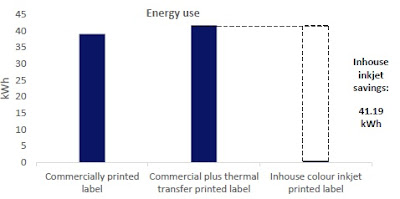Does your
company have sustainability goals? Are
you concerned about sustainability?
 |
| Sustainable Label Production |
If the company
wants to use environmentally sustainable methods of production, you may want to
review your labeling process. This post
outlines how changing one type of labeling method may make your labeling
process much more environmentally friendly and help meet the United Nations
Sustainable Development Goals.
 |
| On-Demand Color Label Sustainability |
- Commercially printed labels
- Inhouse Thermal Transfer printed labels
- Commercially printed “Shell” labels with variable data added with a thermal transfer printer
- Inhouse On-Demand color inkjet labels
These 4 different printing methods would seem to account for the vast majority of labels produced each year. As you can imagine, these different methods produce a different impact on the environment. Epson published this paper outlining how on-demand color inkjet printing offers a more sustainable method for producing labels.
And
get the report by Smithers here:
 |
| Label Sustainability Comparison |
This study
concludes that by moving to on-demand color inkjet labels, companies would make
major progress toward printing labels in a sustainable method and reaching the
United Nations Sustainable Development Goals.
Especially SDG
7: Affordable and Clean Energy
Inkjet printers
are a far less energy intensive process
SDG 9: Industry,
Innovation and Infrastructure
Inkjet printers
can reduce waste of materials and stock obsolescence
And SDG 12:
Responsible Consumption and Production
Inkjet printing
reduces waste materials significantly (ribbons)
Let me tell you
how changing your labeling process makes your company more sustainable in 3 key
areas.
Energy
 |
| Inkjet Energy Savings |
Energy
consumption differences between the different label printing methods are
extreme. On-demand color inkjet uses approximately only 1% of the energy to
print labels compared to commercially printed labels or commercial plus thermal
transfer printed labels. In fact,
Smithers calculates that if the European market would move from these
commercial/thermal transfer methods of label production to on-demand color, the
energy savings would power 95,960 homes for 1 year.
 |
| Inkjet Energy Savings |
As the economy
of the United States is approximately 1.38X larger than the European Union, the
energy savings would be even larger here.
Therefore, moving from commercially printed “shell” labels with thermal
transfer variable data to inkjet labels would save enough energy to power probably
over 132,000 homes for 1 year. The
energy savings is significant by moving to on-demand color. For me, this energy
savings is the most important aspect as it enables reduced CO2 impact from labels.
Waste
 |
| Inkjet Label Waste Savings |
For Jacob
Kallergis, Product Manager for Epson Europe, label waste is most
important. You may remember my recent
post on food certifications based on information provided by Jacob.
According to
Jacob, “I find the amount of
waste from preprinted and thermal transfer labels as most important. When
trying to save and reduce costs, wasted labels
are usually one of the elements most companies ignore when doing a cost
analysis.” 25,264 soccer fields of
wasted labels each year sounds terrible.
In the United States, this number would exceed probably 30,000 soccer
fields.
 |
| Wasteful Label Inventory |
According to the Smithers study, up
to 11% of preprinted labels are wasted; from start up, make ready or
misprints. Further, preprinted label
inventory obsolescence is a major waste factor, with Smithers reporting that up
to ½ of stock labels for certain brands go bad each year.
Ink And Consumables
 |
| Thermal Ribbon Waste |
In
addition to energy consumption
and label waste differences, ink and consumables represent another major difference
between thermal transfer and inkjet label printers. For every square inch of
labels printed by a thermal transfer printer, a square inch of wasted ribbon is
produced. In Europe, the equivalent of
41 double-decker buses of waste ribbons are produced each year. And a lot of extra ink is wasted. At the same time, Epson recycles a large
number of inkjet cartridges; and so can you.
Read more here.
Looking at Storage & Transportation
as well as Release Liner, Smithers found no real differences. The entire label industry, however, must find
ways to reduce the amount of liner wasted.
 |
| Inkjet CO2 Reduction |
Overall, Smithers calculates that moving
to On-Demand Color Labelling from Thermal Transfer and Commercial Printing in
Europe would reduce CO2 emissions by 6.7 million tons. And this number in the United States would be
much higher; probably over 9 million tons.
In the report, Ciaran Little VP, Information Division from
Smithers, says “On-demand inkjet color label printing is often now the most
sustainable and operationally efficient choice.”
When asked, why
did Epson complete this project with Smithers, Jacob said, “It is our strategy
to promote not only on-demand color labelling as a method for sustainable label
production, but also increase awareness of this process overall.” Further I asked Jacob, is this research and
the finding believable? Jacob said, “Smithers carried out the analysis
independently, using public available data. As Smithers is a reputable,
independent organization, they have a great wealth of knowledge on labeling. And
their impartiality isn’t disputed. They work with most companies in the
labeling industry, and would not want to risk their reputation.”
In the past,
I’ve written many times about why and how to move away from thermal transfer to
inkjet label printing. Recent posts include the following.
But the impact
on sustainability seems to be the most logical and strongest reason to move
from thermal transfer to inkjet label printing.
If you are an enterprise company with a sustainability program; and/or
if you have banks of Zebra or other thermal transfer printers in manufacturing
plants, distribution centers or warehouses; then consider moving to inkjet label
printers. You’ll help the environment;
and help your company meet their sustainability goals. Contact us if you want to print labels more
sustainable.
Guy Mikel
855-962-7670




No comments:
Post a Comment